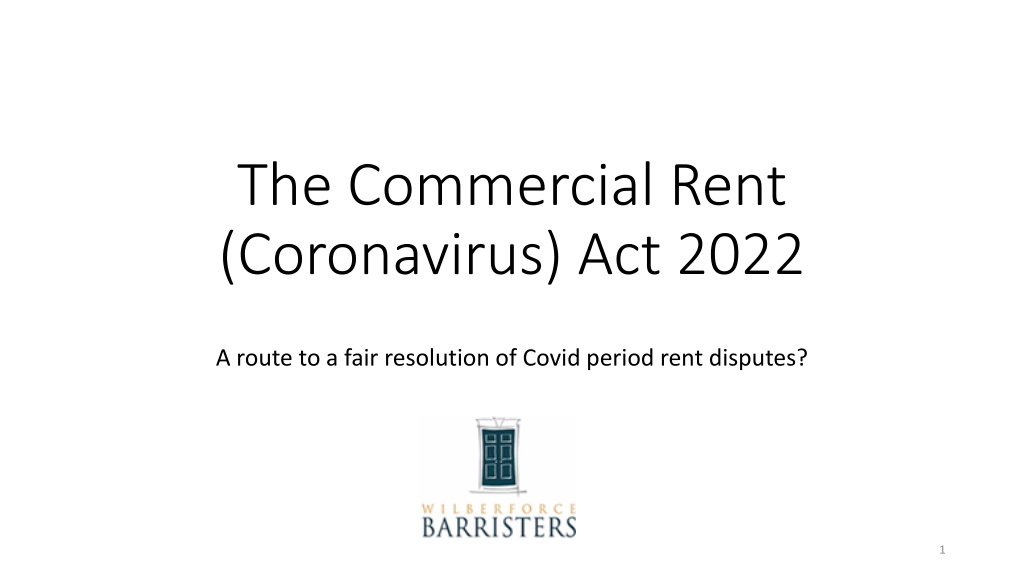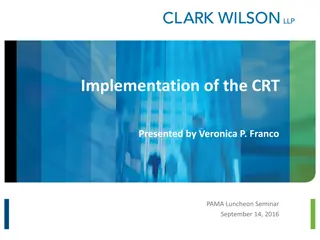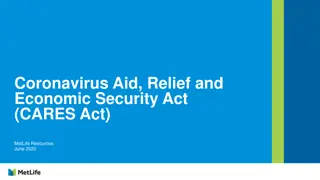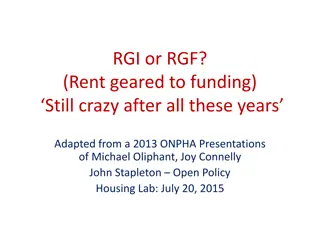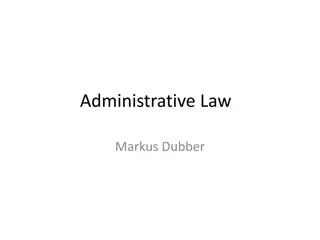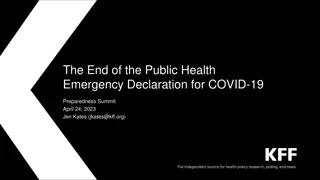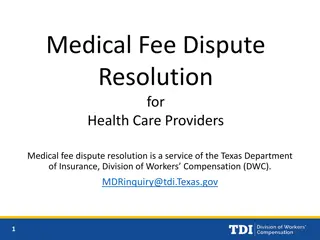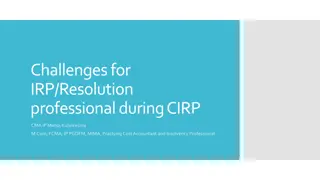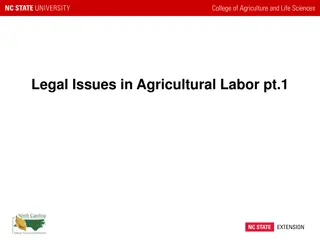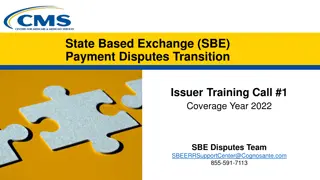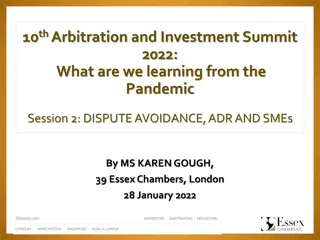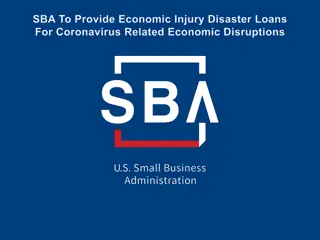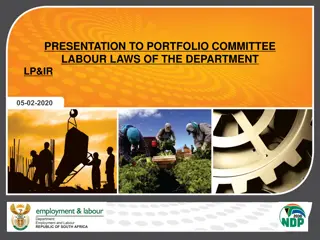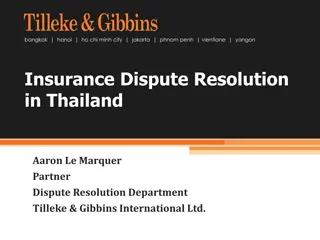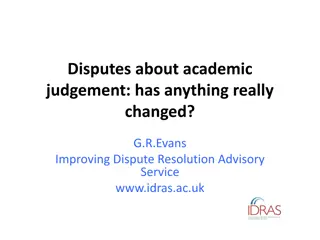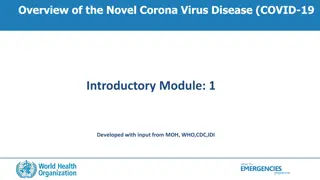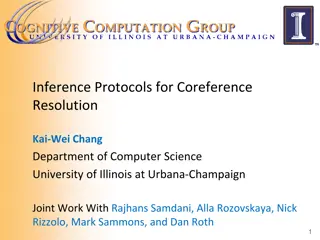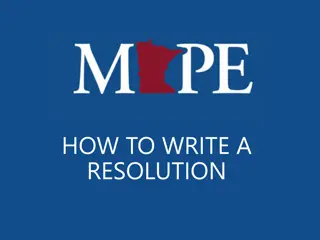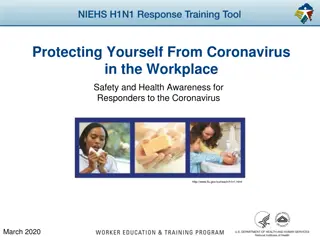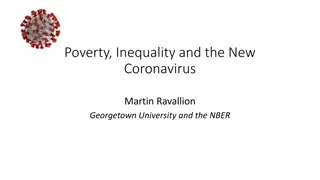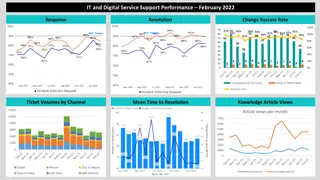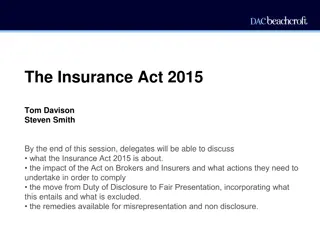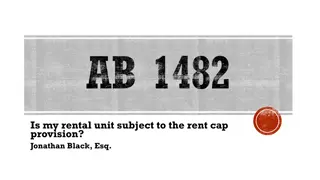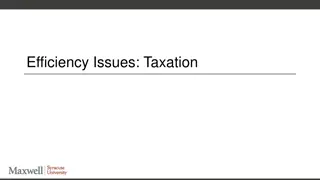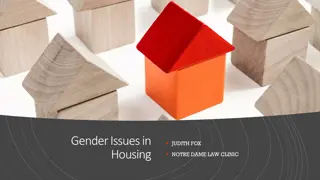The Commercial Rent (Coronavirus) Act 2022: A Fair Resolution for Covid Rent Disputes?
The Commercial Rent (Coronavirus) Act 2022 aims to address unresolved Covid rent arrears, with statistics showing the impact on businesses like pubs, restaurants, and hotels. Case studies of a nightclub tenant and corporate landlord illustrate the challenges faced in negotiating rent repayment terms. The Act seeks to provide a route to fair resolutions between tenants and landlords affected by the pandemic.
Download Presentation

Please find below an Image/Link to download the presentation.
The content on the website is provided AS IS for your information and personal use only. It may not be sold, licensed, or shared on other websites without obtaining consent from the author. Download presentation by click this link. If you encounter any issues during the download, it is possible that the publisher has removed the file from their server.
E N D
Presentation Transcript
The Commercial Rent (Coronavirus) Act 2022 A route to a fair resolution of Covid period rent disputes? 1
CRCA 2
Rob Hastie 28 years experience in Property and Commercial Litigation. Speciality in leisure properties, particularly pubs. Last 5 years dealing with over 250 statutory arbitration cases. 3
Housekeeping information Talk should last about 45 minutes. Questions at the end. Notes will be available on request rhastie@hullbar.co.uk or 07792 383451 4
Some statistics 1.75bn of unresolved Covid rent arrears June 2021. 14% of tenants refusing to speak to their landlords about arrears. Business areas most affected: Pubs and bars; Restaurants; Clothes shops; Hotels; and Gyms. 5
Case study -A nightclub (lets call it Romeos) Only nightclub in town. Closed from March 2020 to July 2021 by Coronavirus Act 2020, unlike, for instance pubs which were allowed to open at times during that period. Rent debt 100,000 (5+ quarters). 6
Case study the Tenant. Company tenant, but effectively a family business. Personal guarantors, let s call them John and Susan. Occupied for over 10 years and never missed a rent payment. No pandemic business interruption insurance. Did get some (but not all) grants and furlough support. Trading back at pre-pandemic levels. Limited cash in the bank or saleable assets. 7
Case study the Landlord. Corporate landlord. Business is letting properties. Asset rich. Mortgaged 2/3rds value of estate. Substantial provision for liabilities due to the pandemic. No government assistance. 8
Case study attempts to settle Tenant offered to pay 30% over two years. Landlord wants full payment, over 1 year. 9
Which tenants are covered? Business tenants (1954 Act definition) in England and Wales closed by lockdown regulations who: Still trade. Remain business tenants. Have Covid period rent arrears. Have not reached agreement with their landlord over those arrears. Are not an IVA, CVA or a court sanctioned Compromise/Arrangement. 10
Rent arrears Rent includes Rent; Service charge, which includes: Services; Repairs; Maintenance; Improvements; Insurance costs; and Management costs (including those of a superior landlord). Interest. VAT. 11
Covid period rent From 21 March 2020 to the date the last restrictions were lifted (for England) Garden centres 13 May 2020; Outdoor Sports/Leisure 29 March 2021; Non-essential Retail and self-contained accommodation 12 April 2021; and Hospitality, Nightclubs, Personal Care, Hairdressers, Hotels, B&Bs, Indoor Leisure, Theatres, Cinemas and Large Events Venues 18 July 2021. Appropriation of payments may lead to disputes. 12
Romeos rent debt 75,000 pure rent. 15,000 VAT. 3,000 insurance. 4,000 interest. 4,000 management costs. 100,000 in total. 13
Moratorium Protected debt cannot be pursued until the end of the moratorium period, which is 24 September 2022 unless an arbitration has been started before then. The exception to the moratorium is court judgments obtained before 10 November 2021, which can be enforced. If no arbitration by the end date then whole of Covid period rent can be enforced. 14
What is statutory arbitration? Arbitration is a form of Alternative Dispute Resolution. Usually contractual, but here imposed by statute. Either party can begin it. Other party must then take part. Binding. Reasoned. Appealable in limited circumstances. Published. 15
Stage 1 Pre-arbitration stage Either landlord or tenant serves notice of an intention to refer to arbitration. No requirement to include proposal or evidence. Response within 14 days (optional). Again no requirement to include proposal or evidence. The right to refer to arbitration arises on the 15th day after the Response, or, if no Response, on the 29th day after the notice of intention. 16
Stage 1 Pre-arbitration stage Tenant Why the tenant should put forward a proposal at an early stage: Statutory guidance says it should be provided; Helps identify potential issues in dispute (eg. amount of protected rent); Avoid arbitration if agreement can be reached; Sets out the parameters for subsequent offers; and Shows seriousness. Offer should be within reasonable bounds or may damage credibility of subsequent offers. Make an early reasonable offer and stick close to it. 17
Stage 1 Pre-arbitration stage Landlord Try to get agreement as to the amount of protected rent. If the tenant has not provided evidence, the landlord is entitled to make proposals that provide for little or no relief. Landlord s should seek early disclosure. 18
Appointing the arbitrator Either landlord or tenant can make reference to an approved arbitration body (eg. CIArb) but mostly it will be tenants. What profession? Accountant, insolvency professional, surveyor or barrister? The reference must include a formal proposal and supporting evidence, which must be served on the other party. Applicant must pay the arbitrator s fee. 19
What is a formal proposal? A proposal for resolving the matter of relief from payment of a protected rent debt (s.11(1)). Offer of payment cannot be longer than 2 years. Must: state it is a formal proposal under s.11; have a signed statement of truth; be served on the arbitrator and the other party; and be accompanied by supporting evidence. 20
Applicant pays the arbitrators fee in advance CIArb fee scale 21
Case studyTenants application. Tenant applied for the appointment of the arbitrator. Paid fee of 4,000 (paid off small amount of arrears to get rent debt below 100k). Tenant s formal proposal says that they can pay 30,000 (30% of the total debt) by instalments over 2 years. Some disclosure given. 22
Arbitrators principles The process is based on two principles: 1) business of the tenant, so far as that is consistent with preserving the landlord s solvency; and Preserving, or restoring and preserving, the viability of the 2) That the tenant should, so far as is consistent with (a) be required to meet its obligations as regards the payment of protected rent in full and without delay (s.15(1)). 23
The first principle viability vs solvency Landlord s solvency trumps tenant s viability. Landlord is solvent unless they are, or are likely to become, unable to pay their debts as they fall due. Likely 2 year horizon for tenant s viability. Viability is deliberately not defined. The arbitrator is to assess the viability of the tenant s business in a holistic and common-sense way, considering the circumstances of that business. 24
Landlords solvency Landlord is solvent unless they are, or are likely to become, unable to pay their debts as they fall due. Must have regard to assets and liabilities of the landlord, including other tenancies to which the landlord is a party; and any other information relating to the financial position of the landlord that the arbitrator considers appropriate. Disregard anything done by the landlord with a view to manipulating their financial affairs so as to improve their position in relation to an award. Disregard the possibility of borrowing money or restructuring the business. 25
Case study Landlords solvency. Landlord may not have the ready cash to pay the mortgage instalments in the next 2 years. Landlord is asset rich. Could borrow against or sell those assets to pay debts as they fell due. Ability to borrow must be disregarded. Sale of assets may not be. 26
Things to regard Tenants viability. The arbitrator must have regard to: the assets and liabilities of the tenant; other tenancies to which the tenant is a party; the previous rental payments made; the impact of coronavirus on the business of the tenant; and any other information relating to the financial position of the tenant that the arbitrator considers appropriate. 28
Tenants viability Disregards. The arbitrator must disregard: anything done by the tenant with a view to manipulating their financial affairs so as to improve their position in relation to an award; the possibility of borrowing money or restructuring the business; the availability of a deposit (if the lease would require it to be topped up); and existence of guarantees. 29
Stage 2 Arbitrators initial assessment of eligibility Have the pre-arbitration steps been followed? Is the tenant in an IVA, CVA, compromise or arrangement? Is there an agreement as to the protected rent? Is it not a business tenancy? Is there no protected rent debt? Establishing the amount of protected rent. Will the tenant not be viable even if relief given? Too much other debt. Not paying rent since the end of Covid period. 30
Stage 3 Arbitrators assessment of the matter of relief from payment of a protected rent debt Chances to make a formal proposal: The responding party can serve a formal proposal and supporting evidence within 14 days of receiving the applicant s formal proposal. Problem with the timing if there is a jurisdictional challenge or Stage 2 is not complete. Within 28 days (extendable by agreement) of their formal proposal either party can serve a revised proposal. No statement of claim or statement of defence. 31
Case studyFurther formal proposals Landlord s first proposal: They will not be able to make their mortgage payments if this and other tenants only pay 30%. Tenant s disclosure inadequate can pay more offer 80% over 1 year. Tenant s second proposal: Asserts that landlord can sell assets to fund mortgage payments. Provides further disclosure. Revises formal proposal to say that they can pay 33,000 (33% of the total debt) by instalments over 2 years. Landlord s second proposal Claims landlord having to sell assets = restructuring. The tenant can afford to pay more say 66% over 18 months. Produces accountancy expert report in support. 32
How do we test the parties assertions? Largely the same way we do in court Burden and standards of proof. Inadequate or inconsistent disclosure. Inconsistent statements. External evidence. Expert evidence. Questioning at hearings. 34
Burden and standard of proof. Whoever is asserting must prove. The civil standard will apply balance of probabilities. 35
Disclosure Landlords. Only if asserting solvency issues. Financial statements. Short and medium term liabilities. Cashflow forecasts. 36
Disclosure Tenants. Bank statements since 1/4/19. Financial records and accounts for the period since 1/4/19. Assets and liabilities. Director s remuneration. Details of the impact of lockdown on this tenant. Business interruption insurance. Covid grants/loans received. Debts payable in the next 2 years. Other tenancies. Estimate of next two years trading. 37
Disclosure - Arbitrators powers. Arbitrator can order a party to give disclosure. Cost v benefit. Fishing expeditions? 38
Inconstistent statements. Formal proposals are classed as written statements . Signed statement of truth. 39
External evidence Evidence that contradicts the other party s case. Publicly available online. Benchmarking. Landlord s own records. 40
Expert evidence. Parties can employ expert accountants to help with their proposals but they are not expected to and costs are not recoverable.. Guidance refers to assessing liquidity, gearing and current ratios. Knowledge of profit margins for the various industries must be relevant. Difficulty in serving the same without having full disclosure. The arbitrator can appoint an expert to advise them the costs are then part of the arbitrator s costs. 41
Oral hearing Optional. Either party can request, but it will most likely be landlords. Hearing should be within 14 days of request. Increases the costs. Whoever asks for a hearing will have to pay the hearing fee initially. Representation. Arbitrator may allow cross-examination. Public (unless parties agree otherwise or confidential or sensitive). 42
Award Within 14 days of oral hearing or if no hearing, as soon as reasonably practicable. Arbitrator can determine: no relief; relief based on one of the parties proposals; and if neither proposal is consistent with the principles, what the arbitrator considers appropriate. The award changes the amount of debt legally due, so that the landlord cannot pursue the relieved amount from the tenant, a deposit or guarantors. Provision for what happens if tenant defaults on instalments. 43
Case study Landlord has failed to establish insolvency. Tenant s offer of 33,000 over two years is not consistent with 2nd principle. Landlord s offer of 66,000 over two years is not consistent with 1st principle.. Arbitrator finds 48,000 over two years (ie 2,000 per month). Landlord sought and got a provision that if an instalment is 14 days late, the whole of the balance of the 48,000 becomes due. Guarantors are released from 52,000 debt (even if tenant defaults). 44
Costs Each party must bear their own costs. Arbitrator will usually order their costs to be paid 50/50, but can alter ratio if appropriate. Usual factors: Who is successful party? Conduct? Calderbank offers? 45
Appeal 28 days to appeal the award to the High Court. Appeal would need to be based on either: Mistake by the arbitrator as to the law; and/or A serious irregularity in procedure leading to substantial injustice. 46
Publication of awards Awards are to be public. Confidential parts can be redacted. Likely that the redacted parts will include the names and addresses of the parties. 47
Conclusion Deadline is effectively 23rd August 2022. Increased negotiation between landlords and tenants. Up-front cost will discourage tenants. Late rush of cases and low level of fees, could mean a shortage of suitable arbitrators. Lots of side issues with apportionment of payments, disclosure and valuations. Wild variations in quality of arbitrators and in their decisions. Limited number of appeals. 48
QUESTIONS? Now or To rhastie@hullbar.co.uk or 07792 383451 49
